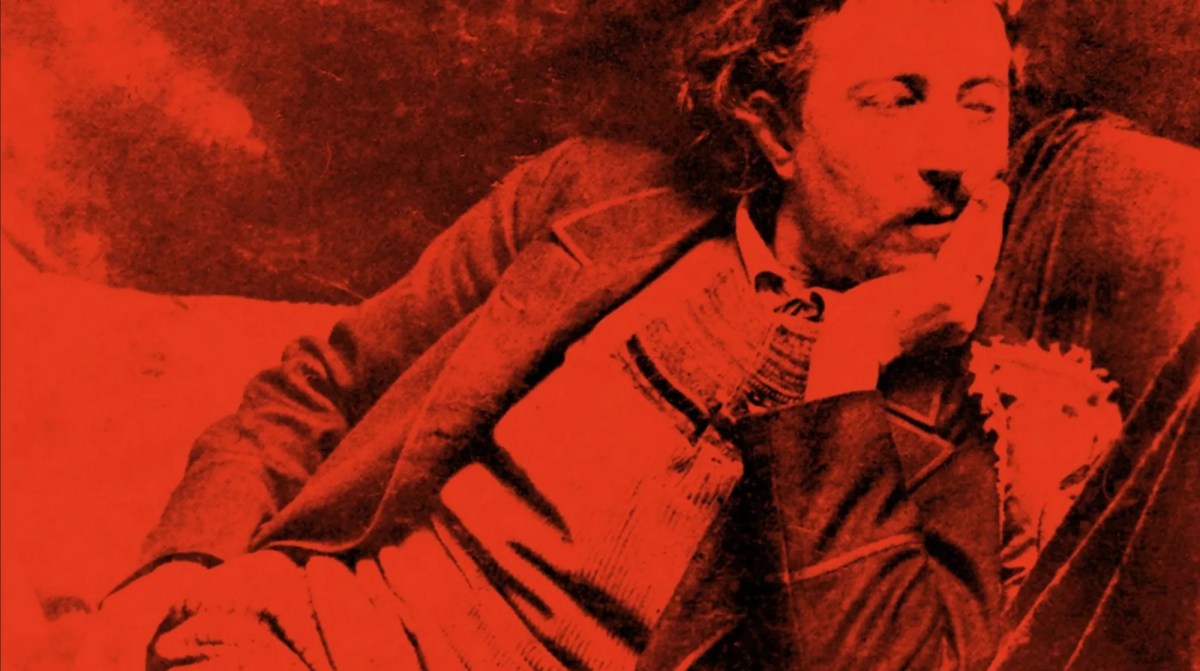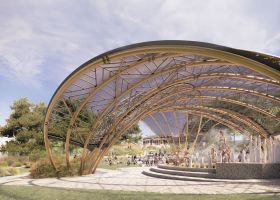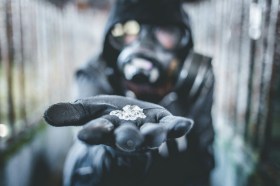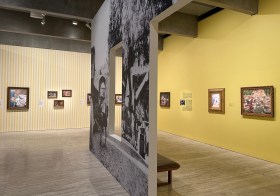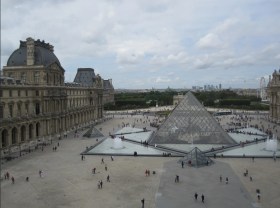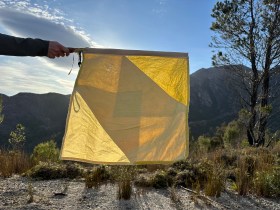Last week, the major exhibition Gauguin’s World: Tōna Iho, Tōna Ao opened at the National Gallery of Australia (NGA) in Canberra.
ArtsHub took a look at that exhibition with a conventional review. It is rich and nuanced in its own narrative of exhibition making; however, it could be considered one-dimensional, or planar.
The NGA clearly feels this too.
What is interesting about the staging of this blockbuster, is what surrounds its staging: an exhibition that butts up to the entry of Gauguin’s World: Tōna Iho, Tōna Ao, and gives agency to Pacific voices, and an almost forensic examination, via a podcast and symposium, of the controversies, the myths and the behaviour of the man that sits behind “brand Gauguin”.
ArtsHub takes a closer look at how art museums can unpick the past, while still presenting it.
In this story:
SaVĀge K’lub: reimagining Moana
As ticket-holders make their pilgrimage towards the temporary exhibition space, through the Brutalist halls of the NGA, it is a burst of colour, with a horror vacui intensity, that stops them in their tracks.
It is the installation SaVĀge K’lub: Te Paepae Aora’i – Where the Gods Cannot be Fooled created by the art collective, SaVĀge K’lub and artist, poet and scholar Rosanna Raymond. The walls have a custom wallpaper, and are stacked high with alternative images of Moana/Pacific life. Some objects from the gallery’s collection sit in museum cases, and cushions are scattered atop straw matting central to the space – inviting audiences to pause, or join public programs scheduled in the space.
It is inviting, not isolating. And it is all about rebooting our perceptions of the Moana/Pacific culture – and the island life that Gauguin painted.

At the opening event for the exhibition, Raymond told Director of the NGA, Nick Mitzevich, ‘We’re not a one-night stand.
‘This project has enabled us to bring, and keep, these relationships strong.’
She spoke about the opportunity of allowing Moana/Pacific artists to sit at the heart of our national institution. ‘We’re really proud to be here, because it’s sort of a voice that’s maybe not known much here in Australia, and it’s our opportunity to actually really say, this is what’s happening today, guys.’
In The Gauguin Dilemma podcast, Raymond says she was initially worried about the association with the Gauguin exhibition, saying, ‘Oh my goodness, am I going to get cancelled because I’m in the same building as Gauguin?’
She continues: ‘Everyone’s [saying] “Oh is it a counternarrative?” And I [explained], “No, it is not a counternarrative. We are the narrative”.’
The SaVĀge K’lub installation is not just a space to look at things. It’s a space to hear, see and feel things.
The installation is conceptually based on a paepae, found throughout the Moana Nui region of the Pacific Ocean and existing outside the main marae (communal or sacred space), forming a threshold across which things pass back and forth.
Read: Role of the add-on exhibition
The Gauguin Dilemma
That back and forth is key to the programming around the major exhibition Gauguin’s World: Tōna Iho, Tōna Ao, including The Gauguin Dilemma podcast, which poses the question: ‘Can you love the art, but loathe the artist?’
Hosted by award-winning Samoan-Australian journalist Sosefina Fuamoli, this four-part podcast series is “knock-your-socks-off” listening, full of myth-busting, quirky personal tales, deep dive thinking and a kind of “throw it in the air” mentality, that leaves both experts and novices considering Gauguin afresh.
Fuamoli says that the NGA approached her, saying: ‘Look, there’s no hiding from the fact that Gauguin is a problematic guy.’
She admits she had to think about doing it. ‘I don’t love old mate Gauguin – not many Islanders do – but I also don’t think “cancel culture” has been very effective.’
Screenwriter and author Maria Lewis agrees. ‘I think the thing that is missing from the phrase “cancel culture” is nuance. And what’s important to talk about is the talk… My friend always says to his daughter, “Are your ears on? Are your ears turned on? Are you listening? Are you doing good listening?” I think that’s what’s really important.’
So Fuamoli leads us through a journey of listening.
Like many Islanders, she grew up with postcards of Gauguin’s art, about which she says she ‘felt a kind of Pasifika pride,’ because there ‘just weren’t that many people who looked like me’, growing up. It is a topic she discusses with artist Angela Tiatia, who speaks about her role in the film Rapa Nui.
‘I was told to stay out of the sun because they needed my skin to be pale. I intuitively felt that there was something wrong with it,’ says Tiatia. ‘But I was also being paid. So there was a weird dynamic, but I didn’t know quite what it was. It had an impact.’
One of the biggest resets begging greater clarity is Gauguin’s relationship with young girls. Was he a paedophile, a rapist, an abuser?
The podcast discusses Gauguin’s painting Manao Tupapau with 13-year-old Teha’amana lying on a bed, naked.
Professor of Art History at Washington University, Dr Elizabeth Childs says: ‘I will resist the choice of the word “girls” because I think that is a contemporary reading.’
She continues that while Teha’amana was just 13, and ‘that’s shocking to contemporary ears, there are several contexts for that, which include that, in France, 13 was the age of sexual consent in the Islands’.
‘It was also an age at which, commonly, young people left their families and lived in partnerships, kinds of trial marriages for a while. This was common among the teenagers of the time he was in Tahiti.’
Childs also notes that the Queen of Tahiti, Queen Marau, married at the age of 15, adding that the greater problem in the eyes of the Islanders was that Gauguin was adulterous.
Fuamoli adds, ‘Here’s something that surprised me. It wasn’t until 2021 that French law was amended, so that any sexual activity with a person below 15 is automatically classified as sexual assault.’
So the podcast starts to build facts and perspective.
A counter position is introduced in the podcast by Ashley Remer, curator of an online exhibition space called Girl Museum. ‘When I found out that the National Gallery was doing this exhibition, I was shocked. By doing the exhibition in the first place you are saying, “We are celebrating this person.” There’s no way around that celebration.’
Remer looks at Gauguin via a feminist lens. The podcast goes on to reflects upon Gauguin’s writings, which confirm that his attitude to woman was unsavoury and often violent.
Also addressed across the four episodes is the role the art market played in the shaping of the master Gauguin. This is in keeping with the belief held by the curator of Gauguin’s World: Tōna Iho, Tōna Ao, Henri Loyrette. As former director of the Louvre Museum and Musée d’Orsay in Paris and an authority on Gauguin from an art history perspective, Loyrette insists that Gauguin didn’t care so much about Tahiti per se – rather he was interested in mood and paintings as stages for an attitude, rather than a place.

Fuamoli adds: ‘Gauguin painted the vision of paradise he set out to find. And it looked like nothing the world had ever seen.’
She continues, ‘Gauguin was like the original influencer, and sailing to Tahiti was like hitting the road for #vanlife #authentic #savage.’
Childs elaborates on this idea. ‘Starting in the 1850s, galleries would start promoting artists, not just on the basis of what they painted, but who they were, where they went, what they did. And something that would set you apart was really key for marketing your work.’
She also sheds light on the role that Gauguin’s Paris-based art dealer, Ambrose Vollard, played in creating a market of demand, and influence upon what he painted. It’s fascinating and layered stuff.
Associate Professor in Art History at Auckland University, Dr Caroline Vercoe joins the conversation: ‘I actually feel like Gauguin’s story has even become bigger than he is.’
She continues: ‘He gave interviews with journalists where he said, “I’m going to live with the primitive people“… But then, of course, he gets there and it’s a figment of his imagination. So, he sought to represent what he wanted.’
The narrative of Western privilege and exploitation runs across the podcast in varying tones. Raymond says, however, that Gauguin wasn’t the first to do this.
‘I think a lot of people think that that gaze started with Gauguin. It started in 1768 when [Louis Antoine de] Bougainville came to Tahiti and brought back tales of these ‘sexually available beautiful women’. And then Captain Cook read Bougainville’s notes. His crew were filled with those stories. So, you know, you get over a century of this myth building before Gauguin got there. I guarantee you Gauguin had read those books.’
So without giving more of a spoiler, this podcast is cracking good listening that pulls the carpet from under those accounts.
We listen, we learn, we ponder, we argue with ourselves and, hopefully by the end of it, we gain a broader perspective on considering the art, the man and his impact upon Pacific culture.
Read: 10 Australian arts podcasts for inspirational listening
The Gauguin Symposium and publication
Completing the trifecta of extended programming is the scholarly arm of Gauguin. Coinciding with the opening weekend of the exhibition, the Gauguin’s World Symposium was presented, with papers delivered by leading contemporary thinkers around Gauguin, including:
- Polynesian artist, curator and architect Miriama Bono, who was Director of Te Fare Iamanaha – Musée de Tahiti et des Îles (2017-2023), coordinating the return to Polynesia of 20 major pieces of Polynesian heritage from the collections of the British Museum, University of Cambridge and the Musée du quai Branly – Jacques Chirac.
- Vaiana Giraud, from the Maison de la Culture in Papeete (2003-21), who is known for her research into Gauguin’s literary approach to Polynesia. Since 2018, she has also been part of the committee working on the creation of the planned Espace Gauguin in Papeari, Tahiti.
- Renowned scholar and curator, Nicholas Thomas, who has worked in Polynesia since 1984, and is perhaps best know as co-curator (with Peter Brunt) of the exhibition Oceania (2018-19), for the Royal Academy of Arts in London and the Musée du quai Branly – Jacques Chirac in Paris, widely considered as a landmark exhibition.
There were also panel talks, allowing for multiple perspectives to be discussed with the “brains trust” in the room. It was a respectful, insightful and enriched space for multiple voices and perspectives to be considered.
Selina Tusitala Marsh, Professor of Literature based at the University of Auckland, says in the podcast, ‘”Gauguin was a monster” just closes down the conversation. Where can you go from there?’
She continues: ‘Making is a cathartic process. It’s a healing process, and it addresses historical trauma. And so it’s like that Japanese art of Kintsugi, where the value is placed in the picking up and the gluing of, or the melding of, these broken pieces with gold, and so that the more gold veins in that vase, the more value it holds because of its age and its preciousness and the fact that it refuses to stay broken.
‘Some people do make in that space of rage, and we need that too. But let it sit along all the other responses.’
Further, Nicholas Thomas, Vaiana Giraud and Miriama Bono, as well as Norma Broude, contributed to the exhibition catalogue at the invitation of Loyrette, to ensure those histories and voices are documented in perpetuity alongside the presentation of this exhibition.
I want to finish with the words of Fuamoli and Raymond. In the podcast Fuamoli asks: ‘So if you were to update things, if you were to correct the record for the 21st century, what would you want people to know about the Pacific today?’
Raymond responds: ‘I want them to know that the “Pacific” is not the name, that three-quarters of the Earth’s surface is known as. I want them to know the word Te Moana–nui–ā–Kiwa. I want them to know about Kupe. I want them to know about the cracks in the reef, about the jelly babies that have been born because of all the radioactive materials in the water. I want them to know that we’re losing species of migratory birds, that we’re losing our sea life because of the acidity in the water. I want them to know that over 10,000 sharks are killed per day. I want them to know that deep-fried food and the cheap, fatty meats that are sold to the Islands are giving our people diabetes. And unless we really can engage and talk about these things, we are going to disappear before the land does.
It puts it all into perspective.
SaVĀge K’lub: Te Paepae Aora’i – Where the Gods Cannot be Fooled at the NGA until 7 October. Free.
The Gauguin Dilemma podcast and transcripts can be downloaded free of charge. The producer for The Gauguin Dilemma is Marcus Costello, associate producer is Olivia O’Flynn, and the Gallery’s Principal Content Strategist and Head of Digital is Marika Lucas-Edwards.
Gauguin’s World Symposium was held at the National Gallery of Australia on Friday 28 June. The publication can be purchased from the NGA Shop.
Gauguin’s World: Tōna Iho, Tōna Ao is showing at the NGA until 7 October. Ticketed.
